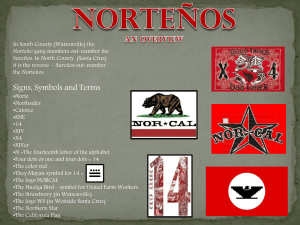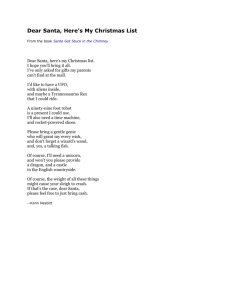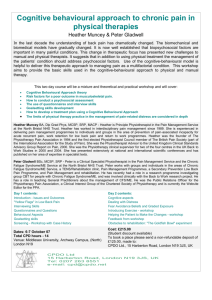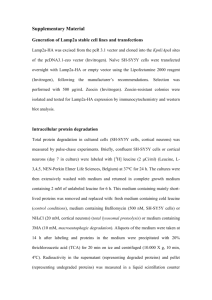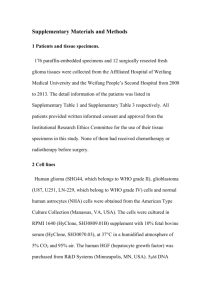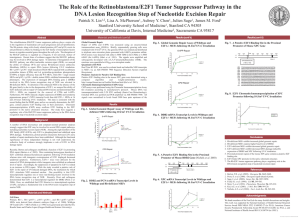Supplementary MATERIALS AND METHODS Patients and Tumor
advertisement
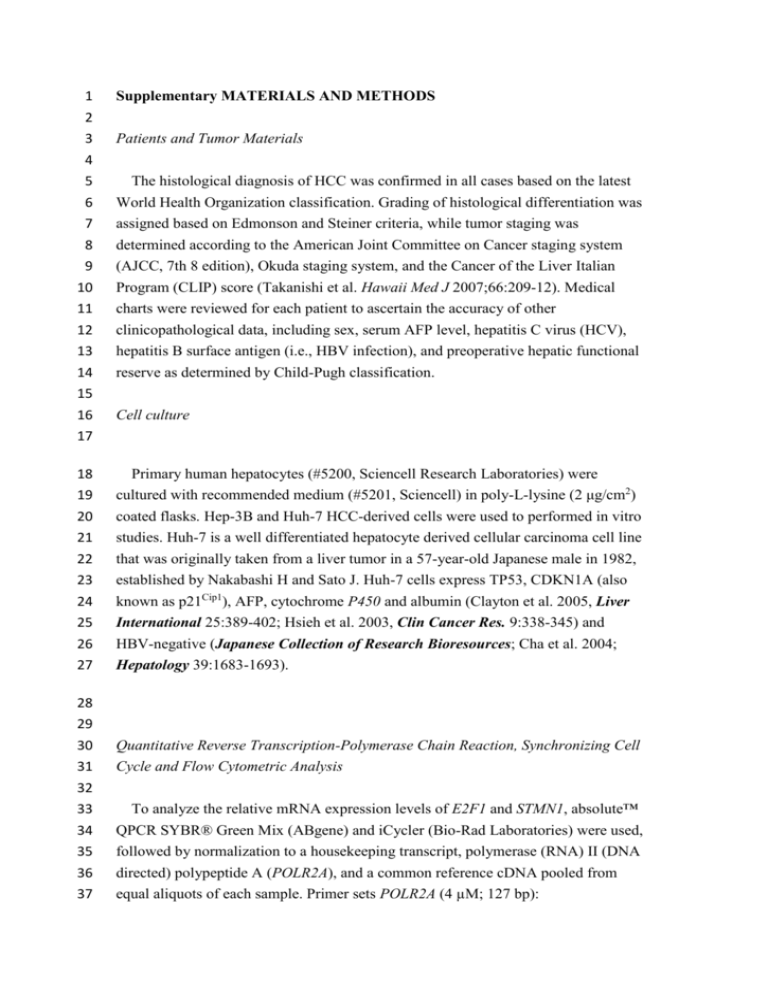
1 2 3 4 5 6 7 8 9 10 11 Supplementary MATERIALS AND METHODS 12 13 14 clinicopathological data, including sex, serum AFP level, hepatitis C virus (HCV), hepatitis B surface antigen (i.e., HBV infection), and preoperative hepatic functional reserve as determined by Child-Pugh classification. 15 16 17 Cell culture 18 Patients and Tumor Materials The histological diagnosis of HCC was confirmed in all cases based on the latest World Health Organization classification. Grading of histological differentiation was assigned based on Edmonson and Steiner criteria, while tumor staging was determined according to the American Joint Committee on Cancer staging system (AJCC, 7th 8 edition), Okuda staging system, and the Cancer of the Liver Italian Program (CLIP) score (Takanishi et al. Hawaii Med J 2007;66:209-12). Medical charts were reviewed for each patient to ascertain the accuracy of other Primary human hepatocytes (#5200, Sciencell Research Laboratories) were 19 20 cultured with recommended medium (#5201, Sciencell) in poly-L-lysine (2 μg/cm2) coated flasks. Hep-3B and Huh-7 HCC-derived cells were used to performed in vitro 21 22 23 24 25 26 27 studies. Huh-7 is a well differentiated hepatocyte derived cellular carcinoma cell line that was originally taken from a liver tumor in a 57-year-old Japanese male in 1982, established by Nakabashi H and Sato J. Huh-7 cells express TP53, CDKN1A (also known as p21Cip1), AFP, cytochrome P450 and albumin (Clayton et al. 2005, Liver International 25:389-402; Hsieh et al. 2003, Clin Cancer Res. 9:338-345) and HBV-negative (Japanese Collection of Research Bioresources; Cha et al. 2004; Hepatology 39:1683-1693). 28 29 30 31 32 33 34 35 36 37 Quantitative Reverse Transcription-Polymerase Chain Reaction, Synchronizing Cell Cycle and Flow Cytometric Analysis To analyze the relative mRNA expression levels of E2F1 and STMN1, absolute™ QPCR SYBR® Green Mix (ABgene) and iCycler (Bio-Rad Laboratories) were used, followed by normalization to a housekeeping transcript, polymerase (RNA) II (DNA directed) polypeptide A (POLR2A), and a common reference cDNA pooled from equal aliquots of each sample. Primer sets POLR2A (4 µM; 127 bp): 38 5’-CCCACTTACTCGCCCACTTCC-3’, 5’-TTCTCCTCGTCACTGTCATCCG-3’; 39 40 41 42 43 44 45 46 47 48 STMN1 (4 µM; 108 bp): 5’-AGAGAACCGAGAGGCACAAATGG-3’, 5’-TCGTCAGCAGGGTCTTTGGATTC-3’; E2F1 (4 µM; 73 bp): 5’-AGATGGTTATGGTGATCAAAGCC-3’, 5’-ATCTGAAAGTTCTCCGAAGAGTCC-3’ and AFP (4 µM; 77 bp): 5’-GAGGGAGCGGCTGACATTATT-3’, 5’-TGGCCAACACCAGGGTTTA-3’ were used. Primer concentrations were optimized to achieve equivalent PCR efficiencies among the control POLR2A and each target gene (Shiue et al. Theriogenology 2006;66:1274-83). Reactions were carried out in triplicate with annealing temperature of 60°C, 56°C, 60°C and 53°C for E2F1, STMN1, CCNA2 and AFP versus POLR2A, respectively. The Coulter®Epics® XL™ flow cytometer 49 50 51 (Beckman Coulter) and WinMDI version 2.9 software were used for cell cycle analysis. 52 53 54 55 56 57 58 Immunoblotting Analysis 59 60 61 62 Calbiochem), E2F1 (1:100; #sc-251, KH95, Santa Cruz), MYC (1:100; #sc-764, N-262, Santa Cruz), TP53 (1:200; #sc-126; DO-1, Santa Cruz), RB1 (1:200; #sc-102, IF8, Santa Cruz) and TFDP1 (1:200; #sc53642, TFD10, Santa Cruz) were used as primary antibodies. Protein bands were detected by Western Lightning™ 63 64 65 66 67 Chemiluminescence Reagent Plus Kit (Perkin-Elmer Life Sciences) with horseradish peroxidase-labeled secondary antibody as suggested by the manufacturer and visualized on a VersaDoc Imaging System (Bio-Rad). 68 69 70 71 72 73 74 75 Cell lysates were prepared with RadioImmunoPrecipitation Assay buffer (Upstate Biotechnology). Lysates containing equal amounts of protein were separated by 12-15% SDS-PAGE and electroblotted into polyvinylidene fluoride membrane (Immobilon TM-P Transfer Membrane, Millipore Corporation). Antibodies against actin, beta (ACTB; 1:3,000; #MAB1501, Chemicon), STMN1 (1:200, #569391, Immunohistochemistry Two pathologists (Huang HY and Li CF) blinded to clinicopathological data and patient outcomes, independently interpreted immunostains of anti-STMN1 (1:20). Immunohistochemical staining was carried out on representative tissue sections cut from formalin-fixed, paraffin-embedded tissues at 5-lm thickness. Sections were deparaffinized with xylene-free EZ-Dewax™ 50 solution (BioGenex Laboratories) and rehydrated. Bond Epitope Retrieval Solution 1 was used to perform antigen retrieval of STMN1 at 100°C for 20 min, respectively. For antigen retrieval of 76 STMN1, Bond Epitope Retrieval Solution 2 was applied at 100°C for 20 min. All 77 78 79 80 81 82 83 84 85 86 slides were washed using Bond™ Wash Solution, and immunostains were performed using the Bond-max™ automated immunostainer (Vision BioSystems), following the standard protocol F of the manufacturer’s instructions. After washing, slides were incubated for 30-40 min at 25°C with primary antibodies. The Bond™ Polymer Refine Detection Kit (Vision BioSystems) was used to detect immunoreactivity on tissue sections, which were then counterstained with Gill’s hematoxylin. One breast cancer specimen previously known to be positive for STMN1 was used as the positive control and incubation without primary antibodies was used as a negative control. 87 88 89 Transient Transfection Cells at a density of 1.5 x 105 were seeded in six-well plates and transfected with pCMV6-XL/TFDP1 (1 μg) and/or pCMV6-XL/E2F1 (1 μg) or pCMV6-XL plasmid 90 91 92 93 94 95 96 (2 μg) (OriGene Technologies, Rockville, MD, USA) in 6 μL TransFast Transfection reagent (Promega). After transfection, cells were incubated at room temperature for 20 min and transferred to an incubator with culture medium for 48 h before analysis. 97 98 99 100 101 102 103 104 105 found to be effective. TRCN0000072243 (shLuc) was served as control. The shRNA clones have been inserted into the pLK0.1 vector, downstream of the U6 promoter. Heh-7 and Hep-3B cells at density of 3 x 106 were transfected with 2 μg shRNA plasmids in 8 μL PolyJet™ DNA In Vitro Tranfection Reagent (SignaGen Laboratories, Gaithersburg, MD, USA), according to the manufacturer’s instruction. After transfection, cells were plated onto 6-cm culture dishes, maintained in a 37°C, 5% CO2 incubator for five days before analysis. Alternations in expression levels of E2F1, STMN1 transcripts, E2F1 and STMN1 protein abundances were analyzed by quantitative RT-PCR and immunoblotting analysis. 106 107 108 109 110 111 112 113 Five shRNA clones targeting E2F1 genes (National RNAi Core Facility, Institute of Molecular Biology, Academia Sinica, Taipei, Taiwan) were preliminarily screened, only two (TRCN0000000250: shE2F1#3 and TRCN0000010328: shE2F1#5) were Chromatin Immunoprecipitation and Quantitative Assays Primers spanning -1,774 to -1,781 (Site 1) and -1,044 to -1,051 (Site 2) of STMN1 promoter region were 5’-AGGACTACACTTCCCGAGGTGCTTC-3’, 5’-TCTGGACCACACTCTGAGCACCAA-3’ and 5’-AGCTTGGGTGGCGGCAGGTT-3’, 114 5’-TAACGGTCCAATCCGGGTAACTCC-3’. One non-specific primer pair, targeting 115 116 117 118 outside of the STMN1 genomic region on chromosome 1, 5’-CCCTGGCCCTGTAGTCATTA-3’, 5’-CCTTGGTATGACCCCTTCAA-3’, was severed as negative control. 119 120 121 122 123 124 Cells were grown overnight in 100-mm dishes to ~60-70% confluency (5 x106), cross-linked with formaldehyde, harvested, and subsequently sonicated to obtain soluble chromatin. After dilution, the chromatin solutions were incubated with 5 μg anti-E2F1 antibody (#sc-251, Santa Cruz, Biotechnology, Inc., CA) or 5 μg IgG pool from rabbit serum (non-specific control), and satiated on a rotating platform at 4ºC overnight. Immunocomplexes were recovered with preblocked protein A-Sepharose 125 126 127 beads (Zymed Laboratories) at 65ºC for 4 h. Samples were next digested with proteinase K (Sigma-Aldrich) for 1 h at 45ºC and the DNA from samples was obtained by phenol/chloroform extraction and ethanol precipitation. Annealing 128 129 130 131 132 133 temperature for PCR was 62ºC. 134 135 136 137 138 139 140 141 142 143 ΔCt(anti-E2F1vector alone – inputvector alone) – ΔC(anti-IgGvector alone – inputvector alone). Relative DNA abundance was calculated by 2-ΔΔCt for both test site and vector alone and normalized to 2-ΔΔCt(vector alone). This experiment was triplicated and the relative promoter occupancy was expressed as mean ± SEM. 144 145 146 147 148 149 150 constructs were verified by sequencing. The mutagenic oligonucleotide primers (mutations were underlined) were, Site 1: 5’CGTGCCTCTGTTTGGATCTTTTGTGCGCGCCC-3’, 5’GCACGGAGACAAACCTAGAAAACACGCGCGGG-3’ and Site 2: 5’-TGGAGGTGTTTTTGGATGGAGTTGGGGGGGGC-3’, 5’ACCTCCACAAAAACCTACCTCAACCCCCCCCG-3’. Resultant PCR products were separated on 2%, 0.5 X Tris/borate/EDTA agarose gels, stained with ethidium bromide; 94 visualized by UV light. For quantitative ChIP, the relative copy number was determined using ΔΔCttest site = ΔCt(anti-E2F1E2F1/TFDP1 – inputE2F1/TFDP1) – ΔCt(anti-IgGE2F1/TFDP1 – inputE2F1/TFDP1) and ΔΔCtvector alone = Generation of Reporter Constructs and Site-directed Mutagenesis The single-mutant (Site 1: pGL3-A/m1E2F1) and double-mutant (Site 1 and Site 2: pGL3-A/dmE2F1) were performed with the QuickChange Lightning Site-Directed Mutagenesis Kit (#210518, Agilent), following the manufacturer’s instructions. All


